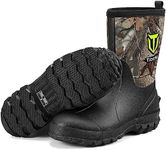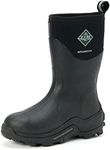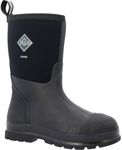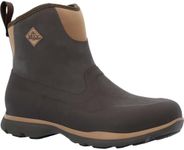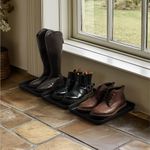Buying Guide for the Best Rubber Boots For Men
Choosing the right rubber boots for men is all about matching your needs with the features that matter most. Whether you need them for gardening, working outdoors, fishing, or just staying dry on rainy days, it's important to consider how and where you'll use them. The right pair should keep your feet dry, comfortable, and protected, while also being easy to put on and take off. By understanding the key features, you can make a choice that will serve you well in any wet or muddy situation.Material QualityMaterial quality refers to the type and thickness of rubber or synthetic material used in the boots. This is important because higher quality materials are more durable, flexible, and resistant to cracking or splitting over time. Thicker, natural rubber tends to be more robust and long-lasting, while lighter synthetic blends may be more affordable and flexible but might not last as long. If you plan to use your boots frequently or in tough conditions, look for boots made from thick, high-grade rubber. For occasional use or lighter activities, a thinner or synthetic material may be sufficient.
Height of the BootThe height of rubber boots can range from ankle to knee-high. This matters because taller boots offer more protection from water, mud, and debris, while shorter boots are easier to walk in and put on or take off. If you expect to walk through deep puddles, mud, or tall grass, knee-high boots are best. For lighter rain or quick trips outside, mid-calf or ankle boots may be more comfortable and convenient.
Sole Type and TractionThe sole type and its tread pattern determine how well the boots grip slippery or uneven surfaces. This is crucial for safety, especially if you'll be walking on wet grass, mud, or rocks. Deep, aggressive treads provide better traction and are ideal for outdoor work or hiking, while smoother soles are fine for city use or gardening. Think about where you'll be wearing the boots most often and choose a sole that matches those conditions.
Lining and InsulationLining and insulation refer to the inside of the boot, which can range from unlined to fully insulated. This affects comfort and warmth. Unlined boots are cooler and better for warm weather or short-term use, while boots with a fabric or neoprene lining add comfort and help prevent chafing. Insulated boots are designed for cold weather and keep your feet warm during winter or in cold water. Choose the lining based on the climate and how long you'll be wearing the boots at a time.
Fit and ComfortFit and comfort are about how the boots feel on your feet, including the width, arch support, and overall shape. This is important because uncomfortable boots can cause blisters or fatigue, especially if worn for long periods. Some boots are designed with extra room for thick socks, while others have a snugger fit. Try to find boots that match your foot shape and consider if you'll need to wear them with extra layers or insoles.
Ease of Putting On and Taking OffThis refers to features like pull tabs, handles, or adjustable openings that make it easier to get the boots on and off. It's important because tight boots can be frustrating, especially if your hands are wet or muddy. If you need to take your boots on and off frequently, look for designs with wide openings, pull loops, or stretchy panels.
Waterproofing and SeamsWaterproofing is about how well the boots keep water out, and the construction of the seams plays a big role. Fully molded boots with minimal seams are usually the most waterproof, while boots with stitched or glued seams may be more prone to leaks over time. If you need maximum protection from water, look for boots with sealed or welded seams and a one-piece construction.




